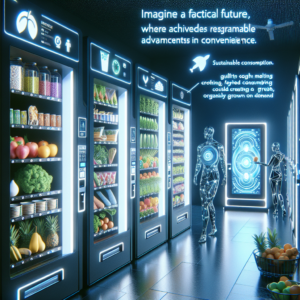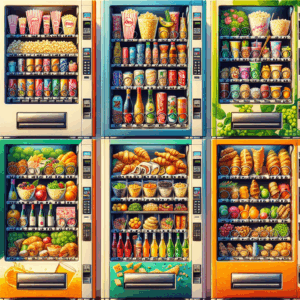Consumer Preferences in Vending Machines
Understanding Consumer Choices
Every time a customer approaches a vending machine, it’s like watching someone partake in a mini-drama. Will they go for the groundbreaking chocolate bar or the good old-fashioned soda? Recognizing these preferences is crucial. Over the years, I’ve observed an increasing demand for healthier options, and it’s quite fascinating to see how these preferences are evolving.
By diving into consumer trends, I’ve noticed that choice is largely driven by convenience and perception of value. People want not just quick snacks, but snacks that make them feel like they’re making a smart choice. This often leads to consumers leaning towards products that boast labels like “organic” or “low-calorie” even if they’re slightly pricier.
Interestingly, this shift in consumer preference is making vending companies reconsider their inventory, nudging them to forgo traditional sugary treats for alternatives like mixed nuts and protein bars. Who would have thought that vending machines could be epicenters of nutritional change?
The Art of Product Selection
Deciding what to stock in a vending machine can be like trying to predict the weather in London—unpredictable, yet thrilling. The research I’ve dissected suggests that when it comes to product selection, diversity is key. Stocking a mix of sweet, salty, and savory can cater to an array of consumer desires.
From my experience, including a few trendy products like kombucha alongside classic sodas creates an intriguing balance. It’s about creating an enticing palette for every palate. Keeping tabs on local culinary trends can also prove beneficial, as regional preferences can sway consumer decisions significantly.
Furthermore, product placement within the machine can impact consumer decisions. Eye-level sweets and impulse-buy sections are known strategies that actually work, proving that sometimes psychology plays a bigger part in choices than actual taste!
Feedback and Adaptability
The last thing you want is for your vending machine to become a ‘sad snack wasteland.’ Engaging with consumer feedback is paramount, and it’s something that often gets overlooked. Installing simple mechanisms like QR codes for quick surveys can give you a pulse on what customers actually want.
Adapting to feedback allows vending companies to stay relevant. Maybe it’s not just about stocking regular chips in your machines, but rather trying out new flavors like spicy hummus. It’s surprising how a little tweak can make all the difference in attracting returning customers.
Listening to feedback doesn’t just help in tweaking inventory; it reflects a business’s responsiveness to change. And, as I’ve learned from marketing, staying ahead of the curve is way more delightful than playing catch-up.
Technological Advancements in Vending Machines
Implementing Smart Technologies
The vending machines I grew up with were simple beasts spewing snacks for coins. Today’s machines? They’re like mini robots with brains! Integrating technology such as touchscreens and cashless payment systems is revolutionizing how consumers engage with vending machines.
Technology brings with it not just ease but also data. The rise of IoT (Internet of Things) technology in this sector cannot be underrated. By utilizing smart technologies, vending operators can track inventory levels and even consumer preferences directly.
From cashless transactions to contactless payments via smartphones, these technological strides have made vending machines more user-friendly, attracting a broader demographic, especially the younger tech-savvy generation.
Data-Driven Insights
Gone are the days of guesswork! Leveraging data analytics from vending machine transactions is becoming a cornerstone strategy. It’s all about understanding your customer, right? Well, the data extracted from each purchase is invaluable in forecasting trends.
Data analysis can potentially allow vending machine businesses to optimize the placement of different products. By understanding purchasing patterns, businesses can anticipate demand spikes and adjust stock levels accordingly.
Moreover, this digital transformation extends to supply chain efficiencies as well, leading to reduced waste and a more refined stocking process. Data, my friends, is indeed the new gold!
Enhancing User Experience
Let’s not underestimate the power of a smooth user experience! With these flashy innovations, it’s easy to forget the core purpose—delighting the user. Interactive displays and multimedia experiences engage consumers at an entirely new level.
Machines that greet customers, provide nutritional information, or suggest combinations of snacks turn a mundane transaction into an enjoyable experience. It’s like the machine is speaking to you, understanding you!
As a marketing enthusiast, I value crafting unique experiences, and it’s quite evident that advanced vending technologies are doing just that. Remember, a happy customer is a returning customer.
Health Trends Influencing Vending Machine Choices
A Shift Towards Healthier Options
The ongoing health revolution has inevitably seeped into the vending machine industry. For years, these machines had a bad rep as ‘unhealthy snack zones.’ Now, companies are flipping the script by offering nutritious alternatives.
Driven by consumer demand, healthy choices like fresh fruit, yogurt, and items low in sugar and sodium are becoming vending machine staples. People are more informed and conscious about their consumption, leading to significant changes in inventory.
Feeding this trend are the rise of diet-conscious individuals and the support from health regulators encouraging healthier options. It’s an exhilarating change and a positive shift for everyone involved—from manufacturers to consumers.
Educating Consumers
Understanding the consumer’s mindset has always been the heart of marketing. Educating consumers through vending machines is a creative way to influence healthier choices. Adding a touch of information about the benefits of a particular snack can tip the scale.
Smarter machines now not only serve food but can also educate users about their dietary intake. Providing calorie count and health tips can nudge consumers towards selecting that gluten-free bar over chocolate.
Through these informative exchanges, vending machines aren’t just about food anymore – they’re about fostering healthier lifestyles. It’s rewarding to witness how a small act of information sharing can influence broader health consciousness.
The Importance of Transparency
Nowadays, transparency isn’t just a buzzword; it’s a consumer expectation. With increasing awareness around food ingredients, ensuring that consumers know exactly what they’re eating is non-negotiable.
Vending machines are stepping up by providing detailed product info, allergen alerts, and nutritional data visibly or digitally accessible. This transparency builds trust and promotes educated decision-making among consumers.
Being honest about what’s behind the wrapper empowers consumers and aligns with the broader movement towards transparency in food labeling. This integrity pays off by fostering customer loyalty and satisfaction.
Economic Impact of Vending Machines on Small Businesses
Boosting Local Economies
Vending machines may seem like silent bystanders, but they’re active players in local economies. They present an opportunity for small businesses to diversify income streams relatively quickly.
As someone deeply invested in marketing dynamics for small businesses, I’ve seen how vending machines offer a low-barrier entry into new markets or complementary services. They can increase the footprint of businesses without the need for extensive retail space.
In economically challenging times, automated vending solutions can bridge financial gaps, creating a steady flow of income, minus the hassles of traditional retail management. It’s a win-win for small business owners looking for diversification.
Cost-Effective Marketing
The vending machine itself can serve as a two-in-one marketing tool and income generator. With graphic decals, digital displays, and promotional offers, they become powerful branding instruments.
Incorporating local flavors or specialty products unique to a community can also transform vending machines into boutique outlets showcasing the diversity and richness of local food culture.
Crafting one’s niche with their vending machines allows small businesses to efficiently reach broader audiences while maintaining minimal overhead costs. It’s all about smart, strategic positioning and maximizing each opportunity.
Innovation and Flexibility
One thing that’s become clear: flexibility breeds opportunity. Vending machines offer unparalleled flexibility to roll out new products with little risk, providing valuable trial-and-error insights.
For small biz folks like us, having the flexibility to innovate without the perilously high stakes of a full product launch can be liberating. Testing new products through vending machines can indicate real-time consumer response and adaptability.
Innovation doesn’t stop there; flexible vending solutions can even double as pop-up culinary experiences or seasonal specialty dispensers. Such dynamism keeps the market fresh and invites endless opportunities.
FAQs
What are the main consumer preferences in vending machines?
Consumers today look for a balance of convenience, healthier options, and perceived value when choosing vending machine snacks. Trends show a rise in demand for organic and low-calorie products.
How has technology transformed vending machines recently?
Recent advancements include smart technology integration, cashless payment systems, and data analytics, which improve user experience and inventory management for vending acumen.
How are health trends impacting vending machine offerings?
Health trends are making vending machines pivot towards offering healthier snack options, responding to consumer demand for nutritious, transparent food choices.
What economic impact do vending machines have on small businesses?
Vending machines can boost small business income, providing marketing opportunities and market entry with minimal investment compared to conventional retail settings.



